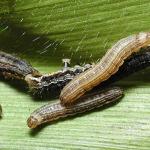Armyworm, Common
Pseudaletia unipunctata
Common armyworm, also known as armyworm or true armyworm, migrates from southern areas anytime from March to September. Sometimes the moths arrive on weather fronts, and sometimes they are blown passively from one place to another. The females lay eggs at night, often in clusters of about 120 to 140 eggs per cluster. Each female can produce up to 2,000 eggs, so it does not take very many females to produce a damaging population of caterpillars. Eggs are laid preferentially on grasses and grains relative to corn and other crops. Larvae feed at night and are grayish green with a broad stripe on each side and a yellow-brown head. In sweet corn, armyworm feeding looks very much like fall armyworm – ragged, chewed leaves, most often in the whorl stage. Fields near wheat or rye are most at risk.
Damage is similar to fall armyworm and is usually sporadic and not sufficient to require treatment. Outbreaks are not common in New England but may occur and cause significant damage.
For current information on production methods (including varieties, spacing, seeding, and fertility), weed, disease, and insect management, please visit the New England Vegetable Management Guide website.
Crops that are affected by this insect:
The Center for Agriculture, Food and the Environment and UMass Extension are equal opportunity providers and employers, United States Department of Agriculture cooperating. Contact your local Extension office for information on disability accommodations. Contact the State Center Director’s Office if you have concerns related to discrimination, 413-545-4800 or see ag.umass.edu/civil-rights-information.
